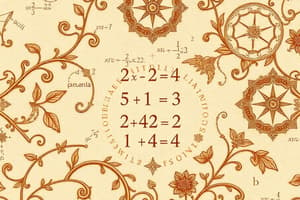Podcast
Questions and Answers
What is the property of real numbers that states that the order of the numbers does not change the result?
What is the property of real numbers that states that the order of the numbers does not change the result?
- Distributive property
- Inverse property
- Associative property
- Commutative property (correct)
What is the type of polynomial that has three terms?
What is the type of polynomial that has three terms?
- Trinomial (correct)
- Binomial
- Quadrinomial
- Monomial
What is the method used to solve quadratic equations of the form ax^2 + bx + c = 0?
What is the method used to solve quadratic equations of the form ax^2 + bx + c = 0?
- Graphical method
- Factorization method
- Quadratic formula (correct)
- Algebraic method
What is the angle formed by two lines that intersect at a right angle?
What is the angle formed by two lines that intersect at a right angle?
What is the type of triangle that has all sides of equal length?
What is the type of triangle that has all sides of equal length?
What is the formula used to find the area of a rectangle?
What is the formula used to find the area of a rectangle?
What is the measure of central tendency that is the middle value of a dataset when it is arranged in ascending order?
What is the measure of central tendency that is the middle value of a dataset when it is arranged in ascending order?
What is the probability of an event that is certain to happen?
What is the probability of an event that is certain to happen?
Flashcards are hidden until you start studying
Study Notes
Numbers and Operations
- Real Numbers:
- Introduction to real numbers
- Properties of real numbers (commutative, associative, distributive)
- Representation of real numbers on a number line
- Polynomials:
- Introduction to polynomials
- Types of polynomials (monomials, binomials, trinomials)
- Addition, subtraction, and multiplication of polynomials
- Factorization of polynomials
- Quadratic Equations:
- Introduction to quadratic equations
- Solution of quadratic equations (factorization method, quadratic formula)
- Graph of quadratic equations
- Linear Equations in Two Variables:
- Introduction to linear equations in two variables
- Solution of linear equations in two variables (graphical method, algebraic method)
- Applications of linear equations in two variables
Algebra
- Pair of Linear Equations in Two Variables:
- Introduction to pair of linear equations in two variables
- Solution of pair of linear equations in two variables (graphical method, algebraic method)
- Applications of pair of linear equations in two variables
- Quadratic Expressions and Equations:
- Introduction to quadratic expressions and equations
- Factorization of quadratic expressions
- Solution of quadratic equations (factorization method, quadratic formula)
- Inequalities:
- Introduction to linear inequalities
- Solution of linear inequalities (graphical method, algebraic method)
- Applications of linear inequalities
Geometry
- Introduction to Geometry:
- Points, lines, and planes
- Angles and their types (acute, obtuse, right, straight, reflex)
- Properties of Angles:
- Complementary and supplementary angles
- Adjacent angles, vertically opposite angles, and corresponding angles
- Triangles:
- Introduction to triangles
- Properties of triangles (angle sum property, exterior angle property)
- Congruent and similar triangles
- Quadrilaterals:
- Introduction to quadrilaterals
- Properties of quadrilaterals (angle sum property, diagonal properties)
- Types of quadrilaterals (rectangle, square, rhombus, trapezium)
Mensuration
- Areas and Perimeters:
- Areas and perimeters of triangles, quadrilaterals, and polygons
- Applications of areas and perimeters
- Surface Areas and Volumes:
- Surface areas and volumes of cubes, cuboids, and cylinders
- Applications of surface areas and volumes
Statistics and Probability
- Data Handling:
- Introduction to data handling
- Measures of central tendency (mean, median, mode)
- Range and interquartile range
- Probability:
- Introduction to probability
- Experimental probability and theoretical probability
- Addition theorem of probability
Numbers and Operations
- Real numbers can be represented on a number line and have commutative, associative, and distributive properties.
- Polynomials can be added, subtracted, and multiplied, and can be factorized into simpler forms.
- Quadratic equations can be solved using factorization or the quadratic formula, and have graphs that are parabolas.
- Linear equations in two variables can be solved using graphical or algebraic methods, and have applications in real-world problems.
Algebra
- A pair of linear equations in two variables can be solved using graphical or algebraic methods, and have applications in real-world problems.
- Quadratic expressions can be factorized, and quadratic equations can be solved using factorization or the quadratic formula.
- Linear inequalities can be solved using graphical or algebraic methods, and have applications in real-world problems.
Geometry
- Geometry involves the study of points, lines, and planes, as well as angles and their types.
- Angles have properties such as being complementary, supplementary, adjacent, or vertically opposite.
- Triangles have properties such as angle sum and exterior angle, and can be congruent or similar.
- Quadrilaterals have properties such as angle sum and diagonal properties, and can be classified into different types.
Mensuration
- Areas and perimeters can be calculated for triangles, quadrilaterals, and polygons, and have practical applications.
- Surface areas and volumes can be calculated for cubes, cuboids, and cylinders, and have practical applications.
Statistics and Probability
- Data handling involves the study of measures of central tendency, range, and interquartile range.
- Probability can be experimental or theoretical, and has an addition theorem.
Studying That Suits You
Use AI to generate personalized quizzes and flashcards to suit your learning preferences.




